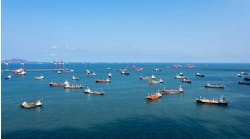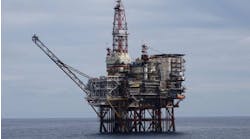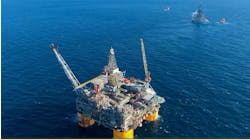Jeremy Beckman • London
Statoil, Hydro see future in subsea compression
Statoil looks to seabed compression to prolong gas production from Aasgard in the Norwegian Sea. The current plan is to qualify suitable technology within six years, followed by installation of the compressor subsea during 2012-13.
Boosting Aasgard’s gas flow via this new technique should offset the reservoir’s natural pressure drop, leading to a potential 25% increase in the field’s gas output (an extra 30-40 bcm). This also will improve the commercial value of the Mikkel and Midgard satellite fields, says Knut Nordstad of Statoil’s research center in Trondheim, which has been working on the seabed system.
The compressor module would be in 250 m of water, 50 km from the Aasgard B platform. Statoil also plans associated equipment for pumping, separation, and filtering, all of which would help sustain production at the surface complex through 2021. Similar solutions could be adopted on Troll in the North Sea, and on Shtokman and Snohvit in the Barents Sea, Nordtsad adds.
Hydro also launched its own pilot subsea compression project, on behalf of the Ormen Lange partners, but this might not be needed before 2014. The Norwegian Sea field is due onstream late in 2007, and should flow gas to the process terminal in Nyhamna, western Norway, for several years via natural reservoir pressure.
If subsea compression is selected for later phases, the equipment would be installed on the seabed at a depth of 860 m. Hydro has commissioned Aker Kvaerner Subsea to engineer and construct a full-size subsea compression station prototype at its yard in Egersund, weighing around 430 metric tons. Vetco Aibel will develop the associated long step-out power supply pilot module; the commercialized version would need to bring electrical power and controls from the Norwegian mainland to the compressor’s location, 120 km offshore Kristiansund.
Assuming partner approval, the contractors would deliver equipment (combined contract value NOK 947 million) in 2009 for a two-year endurance test in Nyhmana. According to Vetco Aibel, one main challenge will be the 145 kV subsea penetrator serving as the connection between the subsea transformers and the undersea power cable.
Hydro sees the subsea option as a much cheaper alternative to putting in a platform or floater, which would be required for a conventional ‘dry’ compression system. Up to four compressor trains could be installed for permanent subsea compression on the field.
Production hubs set for face-lift
In the North Sea, Statoil also views increased compression as the answer to pressure drop in the Sleipner reservoir. The company and its partners just sanctioned a NOK 1.6 billion investment, with the main engineering, construction, and installation contract (NOK 700 million) going to Vetco Aibel. Integration onto the Sleipner B platform will take place during summer 2008.
On Statfjord, the issue is de-pressurization, allowing a switch from oil to gas production, the gas then being exported to the UK mainland. Under the original plan for the Statfjord Late Life project, both the Statfjord and Brent reservoirs were due to be de-pressurized next year, but the partners recently agreed to delay work on the Brent section until 2008, allowing a further 7 MMbbl of oil to be extracted. The Statfjord reservoir scheme will proceed as planned.
Statoil hopes to extend output on Norne in the Norwegian Sea to 2020, via new exploration. Last year it tied back the Urd satellite to Norne’s FPSO, and also installed an extra subsea template to improve recovery from the main field. However, hopes of adding further reserves from the Valkyrie structure, 25 km to the northeast, were dashed by a recent dry well targeting Jurassic sands. Shortly, however, the company plans to appraise the 1990 gas discovery Alve, 16 km southwest of Norne, in an attempt to prove up new reserves in deeper-lying formations. If successful, a development plan could be issued by end-October.
UK’s health clouded by equipment costs and taxes
Overall investment in UK offshore activities rose 15% last year to £9.7 billion, says the UK Offshore Operators Association (Ukooa). Altogether, the sector produced 645 MMbbl of oil and 85 bcm of gas, and spending on exploration and development drilling rose 30%.
This year, Ukooa forecasts a small dip in production across the shelf, to around 3 MMboe/d, but a brief upsurge is likely next year - perhaps to 3.5 MMboe/d - as new oilfields such as Buzzard and Brenda come onstream.
Despite the temporary fall in output, spending is projected to rise this year to £11 billion. However, there are some warning signs, said Ukooa’s Economics Director Mike Tholen during a briefing in London last month. Increased spending is down to equipment shortages, as much as new investment opportunities. Also, out of the forecast 320 new UK well starts this year - up 5% on 2005 - only 50-60 will be exploration-related, representing a drop of 25%. Operators clearly are concentrating on developing fields rather than finding new ones, Tholen said, which is not good for the sector’s long-term future.
Supply constraints don’t help. “The number of rigs available for new North Sea programs at the moment is zero, we believe. That reflects the active drilling picture worldwide, and the massive step-up in programs. In 2004, 50% of North Sea semisubmersibles were in use - now the percentage is 99.5%”.
Some UK operators such as Chevron and Venture are trying to get round the problem, Tholen added, by seemingly taking equity in rigs, thereby guaranteeing availability for long-term projects. “But that’s a brave investment decision, which locks up a large amount of money.”
Rig rates also put some investors off higher-risk, but higher-reward wells in difficult operating provinces, such as west of the Shetlands or the HT/HP corridor in the central North Sea. “If three out of four wells in a campaign are unsuccessful,” Tholen pointed out, “that can mean a $40 million write-off in each case.”
On the plus side, an increasingly diverse range of companies is investing in the UK shelf. Ukooa claims that small producers now account for 10-20% of the total spend, with medium-large companies responsible for over 40% of UK production. But the majors’ share of investment also looks like it will pick up next year, a positive development, said Tholen. “It suggests they recognize that their UK assets still are attractive.”
Doubling the supplementary charge to Corporation Tax last December represented the industry’s third tax rise of recent years. “Our main concern,” Tholen remarked, “is how do we improve our relationship with the government?” Fiscal tinkering makes investors uncertain, he explained, and that could jeopardize the sector’s future.
Ukooa calculates that although its members’ pre-tax revenues from UK operations are rising - due to higher oil prices - post-tax rates of return actually are down on levels in 2002.




